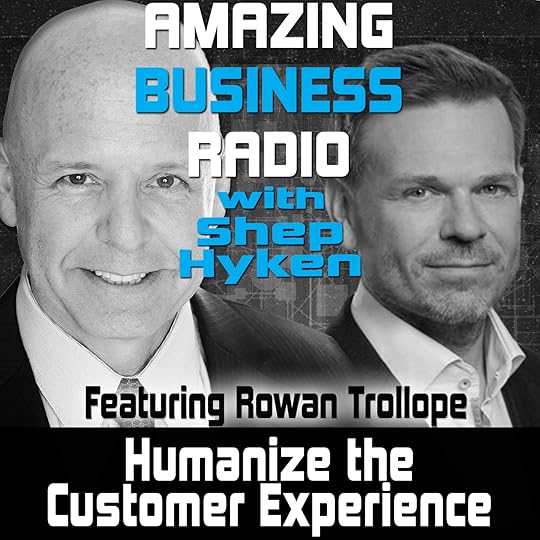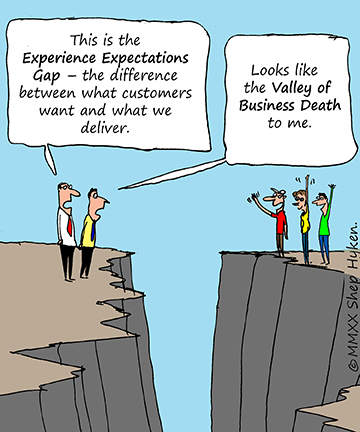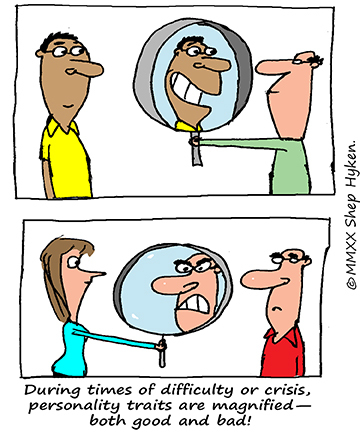Shep Hyken's Blog, page 106
May 11, 2020
5 Top Customer Service Articles For the Week of May 11, 2020
Each week I read a number of customer service and customer experience articles from various resources. Here are my top five picks from last week. I have added my comment about each article and would like to hear what you think too.
How Amazon makes and uses its billions (profits, investments, acquisitions) by Disfold
(Disfold) Amazon is not just a retail company anymore. It is firmly engaged in the broader technology sector, particularly since the launch of Amazon Web Services – AWS – in 2004 which has now grown into the world’s leader in on-demand cloud computing, and a big contributor to the company’s revenues and profits.
My Comment: If you’ve been following my work, it shouldn’t surprise you that whenever a great article about Amazon comes out, I like to share it. This is an interesting look at the Amazon financial model. As big as the retail side is, AWS maybe even more important to the financial health of the company. I found it fascinating. I hope you will, too.
Former Apple CEO John Sculley On The Importance Of Customer Experience by Blake Morgan
(Forbes) Today, Apple regularly tops lists of companies with the best customer experiences and the most innovative products. But that hasn’t always been the case.
My Comment: As long as we’re on the topic of great companies, let’s move from Amazon to Apple. Here’s a peek behind the scenes from former Apple CEO, John Sculley, sharing his view on the importance of customer experience. And when you’re finished reading the article, be sure to listen to the entire interview where Blake Morgan interviews Sculley. The link to the podcast is at the end of the article.
Customer experience, innovation, artificial intelligence, culture….a look inside Amazon – Interview with Claire Whitaker by Adrian Swinscoe
(Adrian Swinscoe) Today’s interview is with Claire Whitaker, a product and artificial intelligence (AI) consultant, who over the last nine years has worked in lean innovation, customer experience (CX), product management and technology including AI teams at top companies across industries, including Amazon. Claire joins me today to share some insights from her experience and, particularly, from her time at Amazon.
My Comment: We’re back to Amazon… kind of. Adrian Swinscoe interviews Claire Whitaker, an artificial intelligence (AI) consultant who spent five years working at Amazon. Swinscoe shares highlights from his interview focused on innovation and the customer experience. My favorite tip from the interview: Start with your customer… Try and get their point of view because from there everything else will fall in place.
Happy employees are your customer experience secret weapon by LogMeIn
(VentureBeat) Customer experience has long been predicted to overtake price and product as the key differentiator for brands, and in 2020 companies are on board and investing heavily.
My Comment: I share many articles on this topic. It’s short and to the point, reminding us how important it is to focus on employees as much, if not even more so, as customers. What happens on the inside of an organization is felt on the outside by the customers.
The Human Experience Trumps CX and EX in Times of Crisis by Howard Lax
(CustomerThink) In other words, how do companies maintain the Customer Experience/Relationship and Employee Experience/Engagement through a period of uncertainty and stress touching every aspect of their lives?
My Comment: We’ll close out this week’s Top Five with a reference to COVID-19. The author offers some very sound advice about managing the customer experience in the midst of a crisis – COVID-19 or any other crisis. The author says it well: “There is no silver bullet, no magic potion. But if I may offer one piece of advice, it is this: In times of crisis, it is the human experience, not the customer or employee experience, that matters.”
 Shep Hyken is a customer service expert, professional speaker and New York Times bestselling business author. For information on The Customer Focus™ customer service training programs go to www.TheCustomerFocus.com. Follow on Twitter: @Hyken
Shep Hyken is a customer service expert, professional speaker and New York Times bestselling business author. For information on The Customer Focus™ customer service training programs go to www.TheCustomerFocus.com. Follow on Twitter: @Hyken
The post 5 Top Customer Service Articles For the Week of May 11, 2020 appeared first on Shep Hyken.
May 8, 2020
Guest Post: Why Anecdotal Customer Feedback is Dangerous
This week we feature an article by Jay Baer, founder of Convince & Convert. He shares insight on gaining and interpreting customer feedback.
Editor’s note: This post was originally published on Jay Baer’s site, Convince & Convert .
Customer feedback is a gift. I believe that. I wrote a whole book about it called Hug Your Haters.
Indeed, customers are doing you an enormous favor by taking the time to alert you to a problem when it occurs, or to their happiness, when that’s the outcome.
The value of feedback is heightened today, as customer experience sways purchase decisions more than ever. Thus, listening to and analyzing customer feedback is crucial to make sure the company meets or exceeds ever-escalating expectations.
But making customer experience changes based on customer feedback isn’t always wise, as you’ll see in this article.
My friend Tom Webster has said many smart things, but one of my favorites is this:
The plural of anecdote is not data.
An anecdote is just a story. And too often we use stories, which began as customer feedback, to shape our company operations.
This is dangerous. But it happens all the time.
How does this occur? How do we end up in a place where listening to customer feedback may actually be harmful?
When You Don’t Look Hard Enough for Customer Feedback
As discussed in Hug Your Haters, your customers are talking about you in more places and in greater numbers than you probably know. For instance, the overwhelming majority of tweets about a business do NOT tag the business in question. Also, there is a lot of chatter about companies in discussion boards and forums, where many businesses do not actively listen.
The result of not listening hard enough is that the volume of customer feedback is diminished. Consequently, when you haven’t collected all that much feedback from customers, the feedback you DO get is magnified in its importance. In this scenario, it’s easier to spin specific pieces of feedback into anecdotes: stories that you can use to shape the CX narrative how you prefer.
When You Embrace the Outliers of Customer Feedback
We remember really angry customers. And we remember customers who are incredibly happy and satisfied. This is human nature: we discuss different and ignore average.
But, when you’re looking at your customer feedback and trying to decide what it all means, it’s disproportionately easy to remember the five stars and the one stars, turning that sliver of the whole into anecdotes and calling them data.
Danger: Customer Feedback Ahead
Why is this a problem? What’s the downside of using just a few customer viewpoints to help shape how and why you do things in your company?
Because truth requires math. An anecdote — even a great and powerful one — is just a blip. One (or even a handful) of customers should never shape your customer experience decisions, regardless of how persuasive, powerful, or poignant their feedback. The opinions of one customer, in one circumstance, in one moment in time, based on their specific experience is just that: ONE experience.
And that can create feedback that is VASTLY different and dangerously contradictory.
I learned this lesson quite clearly last year.
When Customer Feedback Collides
My newest book is called Talk Triggers: The Complete Guide to Creating Customers with Word of Mouth. Written with Daniel Lemin, Talk Triggers is comprehensively researched and includes the 4-5-6 system for creating word of mouth strategies that acquire customers (4 Requirements of a Talk Trigger; 5 Types of Talk Triggers; 6-step Process for creating Talk Triggers).
Because the book is about word of mouth, Daniel and I decided the book should have a feature that stands out; something to create conversation among readers.
We included three. First, the cover is hot pink and features alpacas. Second, the inside has tear-out pass-along cards readers can use to recommend the book. And third, the book has an iron-clad guarantee. The back of Talk Triggers reads:
If you buy this book and do not love it, go to TalkTriggers.com and send the authors a note. They will buy you ANY other book of your choosing.
So far, out of MANY thousands of readers, we’ve had just two redemptions of this very special guarantee.
And they taught me just how dangerous anecdotal customer feedback can be.
The First Negative Customer Feedback
The book had been out five months, and we got our very first request for a different book, from Gary. Said he didn’t like Talk Triggers. Wants a copy of Mark Schaefer’s Marketing Rebellion instead. Good choice. We get his proof-of-purchase and send him the book. Before we ship, we ask him what he found lacking in our book. Gary says:
The number of examples were few compared with the number of companies in the country.
Fair enough, Gary. Although it would be a long book indeed if we aimed to write case studies about all the companies in the country.
The Second Negative Customer Feedback
Fast forward a month. James emails us. Said he didn’t like the book. Requests a $200, out-of-print book about digital marketing instead. We weren’t too thrilled about that, but we bought it for him, and then asked what he didn’t like about Talk Triggers? James replied:
Too many case studies. The book relied on them way too much.
James, meet Gary. Gary, meet James. You guys should get along great.
And that’s why anecdotal customer feedback can be dangerous. Same book. Exactly opposite feedback.
Make your customer experience decisions based on math, not stories.
Jay is a hype-free digital marketing and customer service strategist, speaker, New York Times best-selling author of six books, and a technology investor. He founded Convince & Convert in 2008, and it is his fifth multi-million dollar venture.
F
 or more articles from Shep Hyken and his guest contributors go to customerserviceblog.com.
or more articles from Shep Hyken and his guest contributors go to customerserviceblog.com.
Read Shep’s latest Forbes article: COVID-19 Can Bring Out The Best In Us: A Reason To Smile
The post Guest Post: Why Anecdotal Customer Feedback is Dangerous appeared first on Shep Hyken.
May 6, 2020
Don’t Let Your Customers Fall in the Expected Experiences Gap
I’ve written about the concept of a “gap” a number of times over the years. Each time, the gap was different.
The first time, I shared Dan Sullivan’s principle about the gap between the goal you wanted to achieve and your actual results, if you didn’t hit the goal. The difference was the gap.
Another time I wrote about the competitive gap, which is about the gap or distance you put between you and your competition. The bigger the gap, the bigger your advantage.
Then there was the gap between the service you want the customer to experience and the actual service they receive. Often when leadership is surveyed about how good they think their service and experience is, it differs—in a negative way—from what the customer is actually experiencing. The bigger the gap, the bigger the problem.
Well, the concept of the gap is expanding. Here’s my latest angle on this idea.
I’ve always believed that the customer gets to decide if you deliver on the service you want them to have, as was the subject of the last gap article. However, in the past few years, the customer has become smarter about what a great service experience looks and feels like. They know what great service is because their favorite brands and companies teach them. It could be a big, recognizable brand they shop with or an industry vendor they buy from in their business. The point is that these organizations—your customer’s favorites—are setting a new bar.
The new version of the gap is an expectation gap. It’s the difference between what a customer experiences with the brands and companies they love and what they experience with you and your company. Before our customers became so customer service savvy, the gap was set by the competition. As mentioned in my second article about the gap, hopefully it’s you, not your competition, that is creating a bigger gap. However, this new expectation has less to do with a direct competitor than the idea that the customer now compares you to the best service they have ever had from any brand or organization.
So, what’s your gap? How do you measure against rock star companies? Not just your competition, but the best companies in the world that are creating new levels of customer expectations. Here’s your goal: be the company that creates the gap. In other words, be so good that you are the company all others aspire to emulate. I know, it’s a big goal. How can you compare yourself to Amazon, Apple, Ritz-Carlton, and other iconic service-focused brands? You absolutely can! Become the Ritz-Carlton of your industry. Set the bar high and the gap between what your customers expect and what you deliver gets smaller. Create the smallest gap you can between what your customers expect and what you deliver and the biggest gap between what your competitors deliver and what you deliver.
Shep Hyken is a customer service expert, keynote speaker, and New York Times bestselling business author. For information, contact 314-692-2200 or www.hyken.com. For information on The Customer Focus™ customer service training programs, go to www.thecustomerfocus.com. Follow on Twitter: @Hyken
(Copyright © MMXX, Shep Hyken)
The post Don’t Let Your Customers Fall in the Expected Experiences Gap appeared first on Shep Hyken.
May 5, 2020
Amazing Business Radio: Ronn Torossian

Crisis Management and the Customer Experience
How to Adapt and Handle a Global Crisis Without Sacrificing Your Customers
Shep Hyken interviews Ronn Torossian, CEO of 5W Public Relations. They discuss strategies for managing PR and global crises while strengthening your relationships with your customers.








Top Takeaways:
A key finding from 5WPR’s 2020 Consumer Culture Report was that 71% of people surveyed find it important to buy from companies that align with their values.
When it comes to customer service and customer loyalty, it is important to attempt to understand your customers’ values. If you can resonate with what is important to your customers, you will build a more loyal customer base.
Be mindful not only of what you say, but how you say it. These elements have a huge effect on customer purchasing habits and ultimately customer loyalty.
It is crucial for brands to adapt to worldwide events. For example, many companies that formerly manufactured unrelated products have begun producing items like masks and hand sanitizer to help combat the coronavirus.
There is always a risk for brands to take a stand on moral issues. Companies must be smart and strategic about weighing in on polarizing issues and determine whether the risk is worth the potential gain in customer loyalty.
When in a global crisis, brands need to be careful and mindful of their marketing practices. Attempting to sell could rub consumers the wrong way and risk negatively affecting the brand’s reputation in the long term.
Trust is crucial in any relationship. Businesses must prove to their customers that they are trustworthy.
The goal is for crises to never occur. However, even a crisis could turn into good PR for a brand. The key is in how the crisis is managed.
The process for managing a crisis is to first find out what actually happened. Then, you must decide how to handle it—make a plan of action for both the present and the future. Acting quickly and decisively is crucial.
Don’t forget how to smile and laugh—especially in a crisis. Find at least one thing to smile about every single day.
Quotes:
“Brand sentiment really matters. What you say, how you say it, tone—those things really affect consumer purchasing habits and loyalty.”
“Crisis PR is about telling stories. The key is often to respond quickly. Ignoring a crisis isn’t helpful. You need to be decisive, you need to be strong, and you need to make decisions.”
“People work with people that they like. People buy from companies that they identify with and that have values similar to their own. This is more true now than ever before.”
About:
Ronn Torossian is the founder and CEO of 5W Public Relations. He has worked with some of the world’s most visible companies, brands and organizations and has been recognized with numerous rewards throughout his career spanning over 20 years.
Shep Hyken is a customer service and experience expert, New York Times bestselling author, award-winning keynote speaker, and your host of Amazing Business Radio.
The post Amazing Business Radio: Ronn Torossian appeared first on Shep Hyken.
May 4, 2020
5 Top Customer Service Articles For the Week of May 4, 2020
Each week I read a number of customer service and customer experience articles from various resources. Here are my top five picks from last week. I have added my comment about each article and would like to hear what you think too.
Customer Experience is the way! But where is its value? by Thomas Wieberneit
(Epikonic) What is the experience gap? At the end of the day, it is the mismatch between brand and product promise and delivery to these promises.
My Comment: This is an important article. The topic has been around for years, but we must always keep it “top-of-mind.” This is the gap between what company leadership believes they are providing to customers in the way of an excellent customer experience and what the customer actually perceives it to be. Often there is a gap – and that gap is that the company execs believe they are better than they are. Note: The truth can sometimes hurt!
The Ultimate Customer Experience by Josh Linkner
(Josh Linkner) With glimpses of hope that our economy will reopen in the coming months, it’s time to start thinking about our businesses in a post-pandemic landscape. How will the world change? How will your industry be different? How will you adapt to the new circumstances?
My Comment: There are plenty of articles that are going to be about the economy opening back up and what businesses need to consider as this happens. (I have two of them in this TOP FIVE roundup this week.) Innovation guru, Josh Linkner, has his take, and it’s worthy of your consideration. He offers up an assignment; having a meeting, remote if necessary, to brainstorm the ultimate customer experience. He even gives us questions that will fuel the conversation.
Reopening Faces Its Next Challenge: Retail Marketing by PYMNTS
(PYMNTS) There’s no podcast, textbook or self-help guru that has a playbook on marketing a retail business after a pandemic. But while reopening is the order of the day, re-marketing will be the order of 2020 as retailers try to transcend simple survival and get back on their feet.
My Comment: Not everyone reading this TOP FIVE round up is in retail, but this article, while totally focused on retail, should make us think about how we “reopen” to our customers as we put COVID-19 behind us. Our customers have been impacted in a way that has them thinking and behaving differently. The way we come back is paramount to the long term success we hope to have with our existing customers, as well as new ones – regardless of the type of business we’re in (B2B or B2C).
7 Guidelines Starting Customer Experience by Christine Crandell
(B2Community) Based on our nine years of client engagements, here are seven guidelines to help companies figure out how to get started with their customer experience initiatives.
My Comment: Here is a seven-step list of how to get focused on customer experience. While much of this is a reminder, step two in this process made me want to include the article. Rather than try to “solve for everything,” just look at a few key cases. This turns a potentially daunting task into something much easier to manage. Look at several issues and determine what can be done to eliminate or mitigate problems. Smart idea!
How Sephora & Others Use Customer Loyalty Programs To Drive Revenue by ReferralCandy
(Insane Growth) Shifting your focus to customer loyalty may seem complicated, but in this blog post, we’ve compiled the best resources to help you understand its importance and find ways to make your customers loyal too.
My Comment: What business doesn’t want customer loyalty? It doesn’t matter if it’s B2B or B2C, having repeat business with customers that are also your ambassadors or evangelists is important to any all business. This article focuses on retail (as most loyalty articles do), but as always, I push to consider some of the ideas for B2B. One strategy that works for any type of business is content marketing, which the author discusses as second of his four ideas on how to create loyalty.
BONUS
A Psychological Approach To Management And Leadership After A Socioeconomic Crisis by Matt Wujciak
(CCW) In the past few months, we’ve been thrown a curveball. The pitcher wasn’t on the scouting report and many of us have struck out. But there are innings left to be played. The game is not over.
My Comment: I see light at the end of the tunnel! The economy is starting to open up and we all hope we’re making the right decision to do so. I’m optimistic and know that if we manage this well, we’ll be back to a new “normal” in a few months. This article from our friends at CCW is about leadership and management after a crisis. The article covers productivity, burnout and a number of other topics we should all consider as we move into the post-COVID-19 world.
How To Flatten The Contact Center Curve, According To The Experts by Johnny Rosa
(Zappix) The coronavirus has totally changed all of our lives. Contact centers must adapt and industry experts agree on what they absolutely have to do flatten the contact center curve.
My Comment: The contact/support center was hit hard throughout the crisis. Customers experienced long wait times due to a much higher volume of calls. The term “flatten the curve” has been the term used to describe the strategy of our healthcare system in reducing the number of COVID-19 cases. It is also being used to describe other areas of life, and specifically our contact centers. This article features some expert commentary (honored that the author included my comments) about how companies are managing support and flattening their customer support curve.
Shep Hyken is a customer service expert, professional speaker and New York Times bestselling business author. For information on The Customer Focus™ customer service training programs go to www.TheCustomerFocus.com. Follow on Twitter: @Hyken
is a customer service expert, professional speaker and New York Times bestselling business author. For information on The Customer Focus™ customer service training programs go to www.TheCustomerFocus.com. Follow on Twitter: @Hyken
The post 5 Top Customer Service Articles For the Week of May 4, 2020 appeared first on Shep Hyken.
May 1, 2020
Guest Post: Be The Best Decision Your Employees Ever Made
This week we feature an article by John R. DiJulius III, Chief Revolution Officer of The DiJulius Group. He writes about building a company culture that both empowers and enhances the employee experience, especially during a worldwide crisis.
Your company’s employee experience is on center stage. How we treat the human beings in our organization during this time will be what they remember forever. Every employee is at their most vulnerable state. They need to know they made the best decision when they chose to work for you and your company. How they are treated now will determine that answer. Employees want something to brag about. Let them brag about how amazing their company is and was during these crazy times.
Control the Narrative
You are the only one to tell your story. Employees are hearing misinformation at an alarming rate from all directions which is feeding their fear and anxiety and allowing them to imagine the worst. Employer communication is the most credible source of information during times like this. The 2020 Edelman Trust Barometer showed employees trust their employer over media, government and other sources by a significant margin.
To allow people to get their minds around what is happening and what needs to be done, you need to control the narrative. People are overwhelmed by information overload. They need a voice of reason to crystalize the direction and vision moving forward. Create a definable enemy to galvanize and rally your team against.
Leaders find the truth, get to the brutal facts and separate it from myths, hype, and compromised information. Which is what your strategy moving forward is based upon. Take action. People want to know what to do—they need a plan. Create a flexible plan immediately. Employees want clarity on everything and expect frequent updates. Communicate your short-term and long-term strategy: How we will recover as a company & team? How we will be better off as a result? As well as: How will we return to business? How we will be responsive to workplace safety and be agile to changes in workplace policies to ensure both team members and customers feel safe?
Businesses and leaders need to avoid seeming cold or impersonal and appearing their focus is strictly about the bottom line. These unprecedented times call for us to stretch beyond our normal comfort zones and be even more vulnerable than usual. Six months from now, you’ll look back and be glad you did.
Be Exceedingly Human
Demonstrate your concern for your employees, their very real fears and anxieties, not only professionally and economically, but socially and personally. Even though you don’t have definitive answers to all of their questions, don’t let that keep you from listening to them and empathizing with their fears. They want to know that they can relate to you and that they are not alone in their concerns.
Be Persistent
Track how often every employee is being virtually connected with by a leader from the company. No one should go more than two weeks. This is not a time to hold back. Send people updates and regular communication, even if there is not a lot of new information and the message is largely personal. No one will look back at this time and say, “my manager was so annoying with all the encouraging check-ins with me.” When people are isolated, over-communication is more important than ever.
Have regular video-conference meetings that allow employees to not only talk about work but to share their experiences dealing with this situation. Crises provide an opportunity for people to come to know one another and establish bonds that will endure long after the crisis is over.
Show What Victory Looks Like
Show your employees where your strategic plan will take them and what it will look like when they arrive. People gravitate towards a vision of victory. People are motivated by a promise and a finish line. Teams need a compass and specifics to earn that victory. e.g., “Let’s go make some history —stuff they will talk about for decades to come, that may end up being written about in books, redefining the way things are currently being done.”
If you are confident your business will survive this crisis, communicate that with your employees. Tell them you got this, you got their back, that you won’t let anything happen to them.
Besides laying out our transformational strategy, to further cement my employees’ confidence that they are in the right company, I shared two more things with them: 1) I asked all my companies to set a date at the end of the year to celebrate our comeback victory. I told them to make the reservations at any restaurant of their choice for our victory dinner: and 2) I told them what our brands are doing to help other companies and people during these times. When you help employees see the future vividly and that we are focused on helping others, their fears go down and confidence in their own future rises.
John R. DiJulius III is an author and the Chief Revolution Officer of The DiJulius Group, a customer service consulting firm. He is also the Founder, President and Owner of John Robert’s Spa; Named one of the Top 20 Salons in America with multiple locations (and over 150 employees), which he uses as living laboratories to test his findings and theories.
F
 or more articles from Shep Hyken and his guest contributors go to customerserviceblog.com.
or more articles from Shep Hyken and his guest contributors go to customerserviceblog.com.
Read Shep’s latest Forbes article: Hiring Right In An Employment Crisis
The post Guest Post: Be The Best Decision Your Employees Ever Made appeared first on Shep Hyken.
April 29, 2020
A Reason to Smile During the COVID-19 Pandemic
I’m going to switch up my typical customer service and experience content to share a little motivation.
My buddy and fellow professional keynote speaker, Joey Coleman, is one smart dude. He made a great observation about the way people are reacting to the COVID-19 pandemic. He noticed that the quarantine and stay-at-home orders are magnifying people’s personality traits. For example, if you are an optimistic person, you may be showcasing that side of your personality more than ever. If you’re a giver, you may be exhibiting more generosity than usual by supporting—financially or any other way—healthcare workers, struggling local restaurants, or charity in general. By the way, any negative traits you might have are also amplified.
It made me notice some positive behaviors of certain leaders in business, big and small. When an automobile manufacturer stops building cars and instead builds ventilators, that speaks volumes in an effort to not only give back but try and keep as many people employed as possible even as their sales slip. Consider restaurants that could shut down but instead, choose to stay open with delivery or curbside pickup services to try and give their employees money to live on. Celebrities are doing free concerts and appearances to raise money for our healthcare heroes, people in need and more. Many people, in general, are finding ways to give back.
A friend of mine is in the television business, where the main source of income is advertisers—advertisers who are dramatically cutting back, if they’re even advertising at all. The result is that many TV and radio stations are announcing furloughs and cuts in salary. His company, which owns a chain of stations, chose to do the opposite and announced that even though they are losing money, they would not lay off or furlough any of their employees. Even commissioned salespeople would receive income. The point is that there are many business leaders from all types of businesses and industries that are finding ways to keep their doors open, even if it’s a stretch, just to support their employees. It’s easy to be classy when times are good. But when they are not… that’s when class really counts.
I’m a very optimistic person, yet I’m also a realist. This is a strange and even scary time we are living in. We all watch the news and see the dark side of COVID-19, which includes devastating numbers of illnesses and deaths, financial struggles, and more. Businesses are going under. Unemployment is at an all-time high. A lot of people are hurting. But there is still quite a bit of “good” happening around us. I just shared a fraction of what I know is going on, just to make the point that there are still good people doing good things, often at their own personal sacrifice.
It’s important to find reasons to smile and laugh during dark times. Keep your morale up, and the morale of your colleagues and employees. When you open your eyes and ears to see and hear good, you’ll start to notice even the smallest random acts of kindness happening around you. That alone is a good reason to smile.
Shep Hyken is a customer service expert, keynote speaker, and New York Times bestselling business author. For information, contact 314-692-2200 or www.hyken.com. For information on The Customer Focus™ customer service training programs, go to www.thecustomerfocus.com. Follow on Twitter: @Hyken
(Copyright © MMXX, Shep Hyken)
The post A Reason to Smile During the COVID-19 Pandemic appeared first on Shep Hyken.
April 28, 2020
Amazing Business Radio: Rowan Trollope

Humanize the Customer Experience
How to Stay Connected in a Remote Economy
Shep Hyken interviews Rowan Trollope, CEO of Five9. They discuss strategies for adapting to a remote workforce and ways to humanize a digital customer experience.








Top Takeaways:
A web- or cloud-based interface is an excellent option for working from home, as it allows users access to everything they need without being tied to one specific device or location.
One of the downsides to working remotely is the lack of human interaction and creative in-person collaboration. Communication technology (such as Zoom, Microsoft Teams and Slack) can help combat this.
The biggest mistake companies make when converting to a remote workforce is attempting to recreate the in-office environment. Companies must be flexible and embrace the differences—and benefits—working remotely provides.
Asynchronous work is a huge benefit of working from home. For this to work, managers must trust their employees to do their job and focus on the things that matter. If they do, often employees will come up with more innovative solutions to get their work done.
Humanize the remote working experience. Without “water cooler conversations,” we should encourage people to share information and details from their lives with their team. This will help teams stay connected while being physically distant.
Businesses need to find a way to connect and communicate authentically and empathetically with their customers without a physical presence. Video and voice channels are ideal—but other options may be more feasible or efficient.
The use of emojis is a great way to humanize a digital interaction. Emojis—and even animated GIFs or memes—soften the tone of text and add empathy.
Flexibility between channels of communication is imperative. Consumers want to be able to switch seamlessly between channels without having to start over.
The customer experience starts with the employee experience, and the employee experience starts with leadership. Treat your employees with empathy, authenticity and vulnerability, and they will treat customers better and create a better outcome for your business.
Quotes:
“In the customer service world, the experience that you deliver to your customers is going to start with treat your teams—how you treat your own employees. Having compassion for your employees and being authentic with those employees is what’s defining brands right now.”
“Increasingly, customers expect and will do business with the companies that give them the best customer service experience, not necessarily the best product.”
“A lot of working from home comes down to manager trust. If the manager can trust employees to do their jobs and focus on the things that matter, often those employees are going to figure out new and more innovative ways to get their work done.”
About:
Rowan Trollope is CEO of Five9, a leading provider of cloud contact center software for the enterprise. He is a recognized Silicon Valley leader with a depth of experience in software solutions and cloud innovation.
Shep Hyken is a customer service and experience expert, New York Times bestselling author, award-winning keynote speaker, and your host of Amazing Business Radio.
The post Amazing Business Radio: Rowan Trollope appeared first on Shep Hyken.
April 27, 2020
5 Top Customer Service Articles For the Week of April 27, 2020
Each week I read a number of customer service and customer experience articles from various resources. Here are my top five picks from last week. I have added my comment about each article and would like to hear what you think too.
Shake Shack to return $10 million government loan intended for small businesses by Allyson Chiu
(Washington Post) Shake Shack is returning all $10 million it received from a federal loan program intended to help small businesses amid the ongoing coronavirus pandemic, the burger chain announced in a statement.
My Comment: Our first article in the Top Five roundup is about community. “Giving back” is part of the customer experience. And, that’s exactly what restaurateur Danny Meyer, CEO of Union Square Hospitality and founder of Shake Shack, did when the company gave back $10 million to the government after receiving the funds as part of the PPP stimulus package. In the words of the company executives”… We’re fortunate to now have access to capital that others do not. Until every restaurant that needs it has had the same opportunity to receive assistance, we’re returning ours.”
15 Customer Service Strategies To Help You Deliver A 5-Star Experience by Forbes Coaches Council
(Forbes) If your company is struggling, transforming your customer support into a 5-star experience can inject new life into your business. Not sure where to start? Try these 15 tips from the members of Forbes Coaches Council.
My Comment: It doesn’t matter if we’re in a crisis or in “normal” times, it makes good business sense to deliver a strong customer experience. The Forbes Coaches Council compiled a list of 15 strategies to consider as you and your organization strive to create a “Five Star Experience.”
Top 10 Digital Customer Experience Trends to Look Out For in 2020 by David Gasparyan
(CustomerThink) While product differentiation and marketing strategies are important, companies that focus on customer experience are poised to win in the long run. After all, multiple surveys show that customers are looking for much more than the product when deciding which brands to engage with.
My Comment: Even though we’re at the end of April, it’s still not too late to compile a list of trends in 2020. This list has the author’s “Top Ten” list of digital customer experience trends that will impact our businesses. I’ve written numerous times that technology has the ability to create a better experience, but can also distance a company from its human-to-human connection. The best companies find the perfect balance between digital and human. Here are some ideas/trends to get the conversation started.
How to “Center” Your Business on Customer Experience Excellence by Lynn Hunsaker
(Clear Action) Here are the first 5 of 10 proven principles for centering your business on customers. They will lead to organic growth: an upward trajectory set in motion without ongoing stimuli
My Comment: Creating a good customer experience is more than a strategy. It’s baked into an organization’s culture. Here are five ways to help you get customer-focused. And, be sure to click on the link toward the end of the article for five additional strategies.
Short guide: Delivering great customer service during a pandemic by Harsh Vardhan
(Hiver) Customer service professionals are going out of their way to assist people during the coronavirus pandemic. But, delivering great customer service is not easy at this time. Many support reps have just started working remotely. It’s a difficult time for them as well. They’re helping their families cope up with unpredictable situations. And they still have to keep assisting customers.
My Comment: We’re still in the middle of the COVID-19 pandemic, but there is light at the end of the tunnel. As I read this article, I thought about how we’ve been treating our customers throughout this time of crisis – and it’s been wonderful to see how so many companies and people are stepping up. Delivering customer support and working remotely has put a strain on businesses and customers, but we’ve endured. There are a number of lessons here, and this article shares some of them.
Shep Hyken is a customer service expert, professional speaker and New York Times bestselling business author. For information on The Customer Focus™ customer service training programs go to www.TheCustomerFocus.com. Follow on Twitter: @Hyken
is a customer service expert, professional speaker and New York Times bestselling business author. For information on The Customer Focus™ customer service training programs go to www.TheCustomerFocus.com. Follow on Twitter: @Hyken
The post 5 Top Customer Service Articles For the Week of April 27, 2020 appeared first on Shep Hyken.
April 24, 2020
Customer Service in the Time of COVID-19
This week we feature an article by Paul Selby, a product marketing director for ServiceNow Customer Service Management. He shares tips and examples of how both companies and customers can adapt during a worldwide crisis, such as the COVID-19 pandemic.
An open letter to companies—and customers—on how to navigate the challenges of these extraordinary times.
Editor’s note: A version of this article first appeared on Forbes and CustomerThink .
To say we live in interesting times is an understatement. Social distancing. Quarantines. Toilet paper panic buying.
To put it bluntly, things are not normal out there. COVID-19 is impacting people on myriad levels and will continue to do so for the foreseeable future. During this challenging time, we must adjust our behaviors both as customers and companies, working together to get through it. That includes how we interact in the realm of customer service.
Start with patience, kindness, and understanding
Companies: Behind the scenes you are undoubtedly doing everything you can, with whatever resources you can muster, to address and mitigate the spike in volume you may be experiencing. Assure customers they will be assisted as quickly as possible and allow them to leave voicemail messages, send emails, or use social media channels that enable future follow-up.
If your business has been hit hard, set clear expectations on customer service telephone lines and provide updates on websites, such as this notice on the Airbnb website:
Wait times are longer than usual right now. Due to COVID-19, we’re currently receiving a high number of requests and working with reduced staff. If you have a reservation that is more than 72 hours away, please consider contacting us later so we can help those who are traveling or hosting soon. To change or cancel a reservation, go to your trips page or hosting dashboard.
Also consider adjusting policies, in light of this extraordinary situation, to help reduce inquiries on certain topics. For example, Farmers Insurance is reducing car premiums by 25% automatically.
Despite your best efforts, some customers will still have unreasonable expectations. Extend that same patience, kindness, and understanding to your agents on the front lines.
Customers: Know that contacting customer service is going to take longer, especially with hard-hit companies like hotels and airlines.
Recognize that companies are doing their best to respond, but might be short-staffed or still piloting a hastily-started work-from-home program. Remember there are other customers who also need assistance. When you do reach a representative—even if it takes hours or days—continue to demonstrate grace when the agent apologizes for the wait.
In general, expect everything—be it ordering something or getting the answer to a simple question—to just take longer.
Use every resource you’ve got
Companies: Many organizations are facing the double whammy of increased customer service volumes and potentially fewer staff. Now is the time to double down on self-service. While now may not be the ideal time to launch something new, you should make sure existing tools and programs—knowledge bases, chatbots, communities, and automation, for example—are all operating well and providing up-to-date information.
If new self-service solutions can be added and supported through existing channels, then add them. Remind customers waiting on telephone lines and in chat queues of these instantly available resources.
Take a look at the American Airlines COVID specific page they’ve created. It not only has a video from its Chairman and CEO, but the page has outlined its updated policies and also provides a lot of self-service information to help travelers cancel a trip on their own.
Customers: Start your search for answers online. Most companies today offer a variety of self-service options.
These tools are available around the clock and provide solutions to most common issues. When you use them, it provides a faster resolution for you—and frees up a live agent to address other, more complex issues.
Look for opportunities to help others
Companies: What superpower can you apply to help customers deal with the crisis? This is not an opportunity to peddle your wares but a chance to keep society moving forward.
Many companies have already answered this call:
Zoom is providing its free videoconferencing software to temporarily closed K-12 schools.
To help entertain housebound kids, Disney released Frozen 2 early on its Disney+ streaming service
The New York Times is providing its pandemic coverage free of charge
Apple Card (in partnership with Goldman Sachs) allowed customers to skip their March payment (and has extended that offer to April) without interest charges.
Customers: Realize these companies will be taking a hit in some form to provide these products and services to everyone in need. Take a moment now to thank them. When the pandemic has passed, continue to support them.
If you have the time and knowledge, help provide answers on companies’ online customer service communities. And don’t forget to help out in your own community. Consider donating blood and volunteering your time to help others.
Getting through this together
Humans have contended with pandemics throughout history. Each time, we’ve adapted and survived. Let’s recognize the unique period we’re in, take a breath, and work our way through it together.
 Paul Selby is a product marketing director for ServiceNow Customer Service Management. Previously Paul held product management and customer service and technical support management roles at several software companies, serving all industry segments and large enterprise to small business and retail customers.
Paul Selby is a product marketing director for ServiceNow Customer Service Management. Previously Paul held product management and customer service and technical support management roles at several software companies, serving all industry segments and large enterprise to small business and retail customers.
F
 or more articles from Shep Hyken and his guest contributors go to customerserviceblog.com.
or more articles from Shep Hyken and his guest contributors go to customerserviceblog.com.
Read Shep’s latest Forbes article: Radically Personal Customer Service Unlocks Customer Love
The post Customer Service in the Time of COVID-19 appeared first on Shep Hyken.





